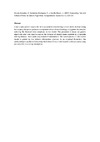Identificador persistente para citar o vincular este elemento:
https://accedacris.ulpgc.es/jspui/handle/10553/15480
| Campo DC | Valor | idioma |
|---|---|---|
| dc.contributor.author | Acosta González, Eduardo | en_US |
| dc.contributor.author | Fernández-Rodríguez, Fernando | en_US |
| dc.date.accessioned | 2016-01-22T10:22:44Z | - |
| dc.date.accessioned | 2018-06-15T09:21:54Z | - |
| dc.date.available | 2016-01-22T10:22:44Z | - |
| dc.date.available | 2018-06-15T09:21:54Z | - |
| dc.date.issued | 2014 | en_US |
| dc.identifier.issn | 0927-7099 | en_US |
| dc.identifier.uri | https://accedacris.ulpgc.es/handle/10553/15480 | - |
| dc.description.abstract | Given a wide amount of possible ratios available for constructing a LOGIT model for forecasting bankruptcy, this paper provides a computational search methodology, only guided by data, for selecting the financial ratios employed in the model. This procedure is based on genetic algorithms which are used to explore the universe of models made available by all possible existing financial ratios (with very redundant information). This search process of the correct model is guided by the Schwarz information criterion. As an empirical illustration, the methodology is applied to forecasting the failure of firms in the Spanish building industry using annual public accounting information | en_US |
| dc.language | eng | en_US |
| dc.relation.ispartof | Computational Economics | en_US |
| dc.source | Computational Economics[ISSN 0927-7099],v. 43, p. 133-157 | en_US |
| dc.subject | 53 Ciencias económicas | en_US |
| dc.subject.other | Financial failure | en_US |
| dc.subject.other | Financial distress | en_US |
| dc.subject.other | Bankruptcy | en_US |
| dc.subject.other | Genetic algorithms | en_US |
| dc.subject.other | Variable selection | en_US |
| dc.title | Forecasting financial failure of firms via genetic algorithms | en_US |
| dc.type | info:eu-repo/semantics/Article | en_US |
| dc.type | Article | en_US |
| dc.identifier.doi | 10.1007/s10614-013-9392-9 | |
| dc.identifier.scopus | 84892500947 | - |
| dc.identifier.isi | 000330035300001 | |
| dc.contributor.authorscopusid | 19638646400 | - |
| dc.contributor.authorscopusid | 6603053452 | - |
| dc.description.lastpage | 157 | - |
| dc.description.firstpage | 133 | - |
| dc.relation.volume | 43 | - |
| dc.investigacion | Ciencias Sociales y Jurídicas | en_US |
| dc.rights.accessrights | info:eu-repo/semantics/openAccess | es |
| dc.type2 | Artículo | en_US |
| dc.contributor.daisngid | 4494041 | |
| dc.contributor.daisngid | 1514720 | |
| dc.contributor.wosstandard | WOS:Acosta-Gonzalez, E | |
| dc.contributor.wosstandard | WOS:Fernandez-Rodriguez, F | |
| dc.date.coverdate | Enero 2014 | |
| dc.identifier.ulpgc | Sí | es |
| dc.description.sjr | 0,32 | |
| dc.description.jcr | 0,521 | |
| dc.description.sjrq | Q2 | |
| dc.description.jcrq | Q3 | |
| dc.description.scie | SCIE | |
| dc.description.ssci | SSCI | |
| item.fulltext | Con texto completo | - |
| item.grantfulltext | open | - |
| crisitem.author.dept | GIR Finanzas Cuantitativas y Computacionales | - |
| crisitem.author.dept | Departamento de Métodos Cuantitativos en Economía y Gestión | - |
| crisitem.author.dept | GIR Finanzas Cuantitativas y Computacionales | - |
| crisitem.author.orcid | 0000-0002-9547-8546 | - |
| crisitem.author.orcid | 0000-0002-8808-9286 | - |
| crisitem.author.parentorg | Departamento de Métodos Cuantitativos en Economía y Gestión | - |
| crisitem.author.parentorg | Departamento de Métodos Cuantitativos en Economía y Gestión | - |
| crisitem.author.fullName | Acosta González, Eduardo | - |
| crisitem.author.fullName | Fernández Rodríguez,Fernando Emilio | - |
| Colección: | Artículos | |
Este elemento está sujeto a una licencia Licencia Creative Commons

